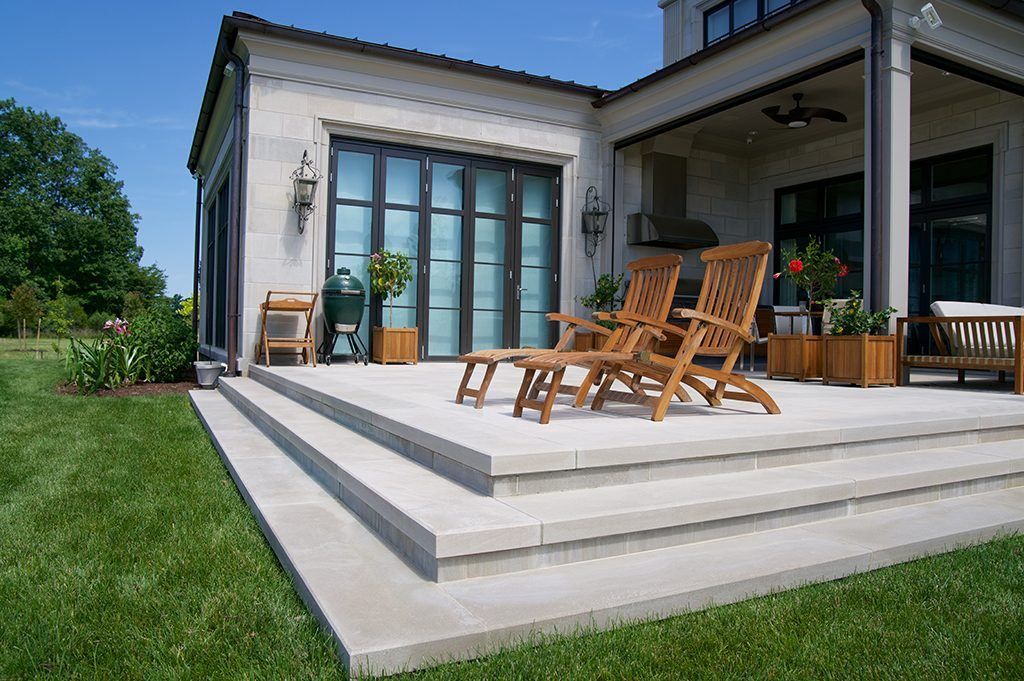Are Limestone Pavers a Good Idea for Patio Pavers?
 Image: Polycor
Image: Polycor
Are limestone pavers good for patio pavers? Will it last? Well, our ancient ancestors used it to build pyramids and they’re still standing, so yes, it will last. We have an abundance of limestone and this sedimentary rock and its use in architecture continues to tell stories of our history when we look at Ancient Egyptian, Mayan architecture and later on Western civilisations.
Limestone is a permeable rock produced from the remains of ancient corals and molluscs, and it is primarily composed of different kinds of calcium carbonate. These compositional qualities make limestone simple to sculpt and cut into sizes and shapes while also being extremely resilient.
The main reason for limestone’s use in present times is its abundance of calcium carbonate, which is used for a variety of applications, from advancing modern building materials like concrete to enriching food through fertilizer to fortifying bread.
It is still quite popular to use limestone pavers for outdoor areas due to its benefits. However, with the aid of modern technology, there is much more potential for the wonders of limestone patio pavers.
 Image: Polycor
Image: Polycor
How About Liquid Limestone?
Even though the name might have some hints of a miracle material, liquid limestone is really not very different from concrete. Despite the slight difference, liquid limestone still utilizes the same basic ingredients – cement, aggregate, and additives. White cement is used instead of commonly used grey cement in making liquid limestone.
Limestone is used as the aggregate rather than sand or gravel, hence the name liquid limestone. Additives are used in a manner similar to regular concrete, although the amount varies depending on the end property.
White cement is one of the most important changes of these changes since it allows the limestone to produce distinctive bright colors (ranging from sandy yellow to bluish-silver) that would otherwise be muted by the strong grey color of standard cement .
Limestone is a widely used aggregate because it has a set of unique properties making it an excellent choice for paving.
Why Choose Limestone Patio Pavers?
The unique formulation behind liquid limestone lets it combine the best of both worlds to create an outdoor paving material like no other. Though it isn’t as fancy as its name implies, it’s a mix of concrete and limestone with a fancy name attached. These are its five most important characteristics:
Solid and durable: Limestone liquid inherits the strength, weather resistance, and unique properties of concrete (covered in more detail in the following section) while avoiding some of the disadvantages of limestone.
Typically, pure limestone is damaged by acids; liquid limestone, though, is protected from such damage by its other components, allowing it to support the weight of a large truck with little to no damage.
Low maintenance: An inherent property of limestone is its porosity, which is reflected in concrete mix. The result is unsightly stains forming over time as dust and debris get trapped in its tiny crevices.
Typically, a sealant will be applied either to the liquid limestone before setting in or to the hardened liquid limestone, in order to compensate for this. As a result, liquid limestone pavers are relatively easy to clean.
In the heat of the summer, liquid limestone retains its pleasantly cool touch despite the great amount of heat it dissipates. The liquid limestone’s ability to disperse heat over a wide area is one of the reasons that it makes such an excellent floor covering for patios, poolside areas, and other exterior paved areas.
We’ve already learned how useful and aesthetically pleasing liquid limestone is as a paving material. It can easily hold up to stones more expensive in terms of durability since concrete and limestone have the same properties.
Liquid limestone’s unique blend of ingredients gives the aggregate a truer look as compared to conventional concrete, which exhibits dull grey hues. Although liquid limestone’s range of possible colors is a bit less varied than that of, say, dyed concrete, the shades resulting from it are quite sought-after for the ‘Mediterranean’ feel it gives off that makes it stand out against other paving options.
Plus, because liquid is poured into place, designers have many options for etching and stenciling, just like standard concrete.
Do Limestone Pavers Need To Be Sealed?
Liquid limestone is more durable than concrete so it will last for many years. It is porous so it absolutely must be sealed. Otherwise debris and algae will collect and cause staining.
What Are the Benefits of Liquid limestone?
Liquid limestone offers a number of excellent qualities that make it a popular choice for many homes and businesses. Among them are:
- The sealant makes the surface stain-resistant, and it is easy to clean.
- People love the look. Whether it’s inside or outside, it looks beautiful.
- As an outdoor flooring solution, it’s a great way to enhance more than just how areas look. In addition to improving your outdoor environment, liquid limestone is also more aesthetically pleasing.
- Other materials absorb the heat from sunlight differently than it does. Bare feet are more comfortable on it than other popular options, such as exposed aggregate.
- The design is fresh and somewhat unique. Surfaces covered by it are distinguished from others in this way. In comparison to traditional concrete, liquid limestone is considered to offer a more Mediterranean look.
Liquid limestone brings a long list of benefits. You may be wondering if there’s a catch, like higher cost? Because limestone pavers are widely available and stable, its prices are much lower than those of granite, slate and other natural stone pavers, which are much harder to get. In addition, due to liquid limestone’s versatility, you can achieve the ‘broken’ look with little or no additional cost by using custom molds and stencils.

